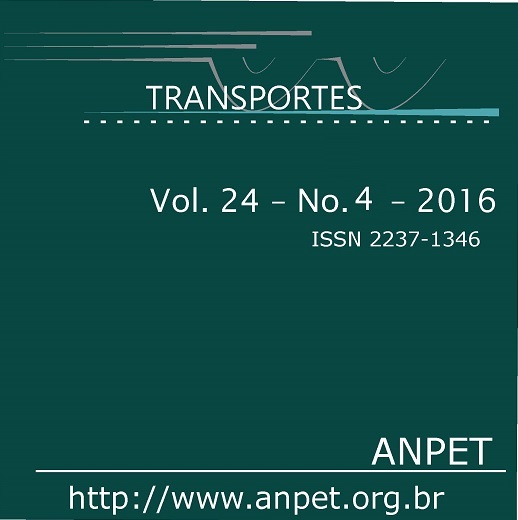Influência das condições climáticas e de acidentes na caracterização do comportamento do tráfego em rodovias
DOI:
https://doi.org/10.14295/transportes.v24i4.1104Keywords:
Clustering, accidents, rain, speed-flow relationship.Abstract
Meteorological and safety-related data have been integrated to several techniques aimed at characterizing the fundamental relationships of traffic flow on highways, in order to better understand traffic behavior in adverse conditions such as rain, and when incidents occurs. In this context, this paper proposes the use of clustering methods to characterize the traffic behavior in highway BR-290/RS, located in the metropolitan area of Porto Alegre - RS. The clustering techniques tested, K-means and fuzzy clustering (FCM), enabled the determination of behavioral patterns influenced by variables (flow, speed, accidents and rain). Clusters related to periods with rain indicate speed drop by about 10 km/h. Clusters periods related to accident conditions indicate speeds between 10 and 35 km/h, and volumes below 1000 veic/h.Downloads
References
Agarwal, M., Maze, T. H., e R. R. Souleyrette (2005) Impacts of Weather on Urban Freeway Traffic Flow Characteristics and Facility Capacity. Final Technical Report, Center for Transportation Research and Education Iowa State University, USA
.
Azimi, M., e Y. Zhang (2010) Categorizing Freeway Flow Conditions by Using Clustering Methods. Transportation Research Record: Journal of the Transportation Research Board, 2173, 105–114. doi:10.3141/2173-13
Caceres, N., Romero, L. M., e F. G. Benitez (2012) Estimating Traffic Flow Profiles According to a Relative Attractiveness Factor. Procedia - Social and Behavioral Sciences, 54, 1115–1124. doi:10.1016/j.sbspro.2012.09.826
Chunchun, H., Nianxue, L., Xiaohong, Y., e S. Wenzhong (2011) Traffic Flow Data Mining and Evaluation Based on Fuzzy Clustering Techniques. International Journal of Fuzzy Systems, 13(4), 344–349.
Dunn, J. C. (1973) A Fuzzy Relative of the ISODATA Process and Its Use in Detecting Compact Well-Separated Clusters. Journal of Cybernetics, 3(3), 32–57. doi:10.1080/01969727308546046
Gettman, D., Pu, L., Sayed, T., e S. Shelby (2008) Surrogate Safety Assessment Model and Validation: Final Report. Federal Highway Administration, Report No. FHWA-HRT-08-051.
Jain, A. K., Murty, M. N., e P. J. Flynn (1999) Data Clustering: A Review. ACM Computing Surveys (CSUR), 31(3), 264–323.
Jia, Y., Wu, J., Du, Y., e G. Qi (2014) Impacts of rainfall weather on urban traffic in beijing: analysis and modeling. Physics and Society, 1–13.
Kianfar, J., e P. Edara (2013) A Data Mining Approach to Creating Fundamental Traffic Flow Diagram. Procedia - Social and Behavioral Sciences, 104, 430–439. doi:10.1016/j.sbspro.2013.11.136
Lloyd, S. (1982) Least squares quantization in PCM. IEEE Transactions on Information Theory, 28(2), 129–137. doi:10.1109/TIT.1982.1056489
Mirshahi, M., Obenberger, J., Fuhs, C. A., Howard, C. E., Krammes, R. A., Kuhn, B. T., Mayhew, R. M., Moore, M. A., Sahebjam, K., Stone, C. J., e J. L. Yung (2007) Active Traffic Management: The Next Step in Congestion Management. Federal Highway Administration, FHWA-PL-07-012, Washington D.C.
Montazeri-Gh, M., e A. Fotouhi (2011) Traffic condition recognition using the -means clustering method. Scientia Iranica, 18(4), 930–937. DOI: 10.1016/j.scient.2011.07.004
Park, B. (2002) Hybrid Neuro-Fuzzy Application in Short-Term Freeway Traffic Volume Forecasting. Transportation Research Record, 1802, 190–196. doi:10.3141/1802-21
Rousseeuw, P. J. (1987) Silhouettes: A graphical aid to the interpretation and validation of cluster analysis. Journal of Computational and Applied Mathematics, 20, 53–65. DOI:10.1016/0377-0427(87)90125-7
Sun, L., e J. Zhou (2005) Development of Multiregime Speed-Density Relationships by Cluster Analysis. Transportation Research Record, 1934, 64–71. doi:10.3141/1934-07
Thakuriah, P., Yanos, G., Lin, J., Metaxatos, P., Sulo, R., Pu, W., e L. Mbekeani (2008) Including Weather Effects In a Real-Time Traffic Information Environment - Exploratory Analysis and Alternative Models. In Proceedings of the 15th Intelligent Transportation Systems World Congress, New York City - USA.
Weijermars, W., e E. van Berkum (2005) Analyzing highway flow patterns using cluster analysis. Proceedings. 2005 IEEE Intelligent Transportation Systems, 831–836. doi:10.1109/ITSC.2005.1520157
Xia, J., e M. Chen (2007a) A Nested Clustering Technique for Freeway Operating Condition Classification. Computer-Aided Civil and Infrastructure Engineering, 22(6), 430–437.
Xia, J., e M. Chen (2007b) Defining Traffic Flow Phases Using Intelligent Transportation Systems-Generated Data. Journal of Intelligent Transportation Systems, 11, 15–24. doi:10.1080/15472450601122322
Downloads
Published
How to Cite
Issue
Section
License
Authors who submit papers for publication by TRANSPORTES agree to the following terms:
- The authors retain the copyright and grant Transportes the right of first publication of the manuscript, without any financial charge, and waive any other remuneration for its publication by ANPET.
- Upon publication by Transportes, the manuscript is automatically licensed under the Creative Commons License CC BY 4.0 license. This license permits the work to be shared with proper attribution to the authors and its original publication in this journal.
- Authors are authorized to enter into additional separate contracts for the non-exclusive distribution of the version of the manuscript published in this journal (e.g., publishing in an institutional repository or as a book chapter), with recognition of the initial publication in this journal, provided that such a contract does not imply an endorsement of the content of the manuscript or the new medium by ANPET.
- Authors are permitted and encouraged to publish and distribute their work online (e.g., in institutional repositories or on their personal websites) after the editorial process is complete. As Transportes provides open access to all published issues, authors are encouraged to use links to the DOI of their article in these cases.
- Authors guarantee that they have obtained the necessary authorization from their employers for the transfer of rights under this agreement, if these employers hold any copyright over the manuscript. Additionally, authors assume all responsibility for any copyright infringements by these employers, releasing ANPET and Transportes from any responsibility in this regard.
- Authors assume full responsibility for the content of the manuscript, including the necessary and appropriate authorizations for the disclosure of collected data and obtained results, releasing ANPET and Transportes from any responsibility in this regard.










